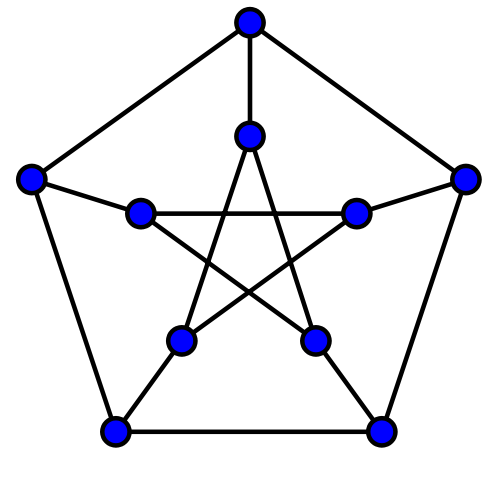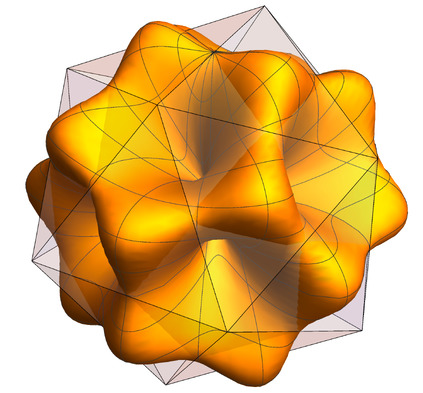Here is a list of exercises to be used during the AMS Short Course “Sum of Squares: Theory and Applications”.
See also the AMS Course Lecture Notes/Slides
Exercise 1
Consider the polynomial \(p(x) = x^4 + 2 a x^2 + b\). For what values of \((a,b)\) is this polynomial nonnegative? Draw the region of nonnegativity in the \((a,b)\) plane. Where does the discriminant of \(p\) vanish? How do you explain this?
Exercise 2
Let \(M(x,y,z) = x^4 y^ 2+ x^2 y^4 + z^6 - 3 x^2 y^2 z^2\) be the Motzkin polynomial. Show that \(M(x,y,z)\) is not SOS, but \((x^2+y^2+z^2) \cdot M(x,y,z)\) is.
Exercise 3
Give a rational certificate of the nonnegativity of the trigonometric polynomial \(p(\theta) = 5 - \sin \theta + \sin 2\theta - 3 \cos 3\theta\).
Exercise 4
Consider a univariate polynomial of degree \(d\), that is bounded by one in absolute value on the interval \([-1,1]\). How large can its leading coefficient be? Give an SOS formulation for this problem, solve it numerically for \(d=2,3,4,5\), and plot the found solutions. Can you guess what the general solution is as a function of \(d\)? Can you characterize the optimal polynomial?
Exercise 5
Consider a given univariate rational function \(r(x)\), for which we want to find a good polynomial approximation \(p(x)\) of fixed degree \(d\) on the interval \([-2,2]\).
- Write an SOS formulation to compute the best polynomial approximation of \(r(x)\) in the supremum norm.
- Same as before, but now \(p(x)\) is also required to be convex.
- Same as before, but \(p(x)\) is required to be a convex lower bound of \(r(x)\) (i.e., \(p(x) \leq r(x)\) for all \(x \in [-2,2]\)).
- Let \(r(x) = \frac{1-2 x+x^2}{1+x+x^2}\). Find the solution of the previous subproblems (for \(d=4\)), and plot them.
Exercise 6
Consider the polynomial system \(\{ x+y^3 =2, x^2+y^2=1\}\).
- Is it feasible over \(\mathbb{C}\)? How many solutions are there?
- Is it feasible over \(\mathbb{R}\)? If not, give a Positivstellensatz-based infeasibility certificate of this fact.
Exercise 7
Consider the butterfly curve in \(\mathbb{R}^2\), defined by the equation
\[x^6 + y^6 = x^2.\]Give an sos certificate that the real locus of this curve is contained in a disk of radius \(5/4\). Is this the best possible constant?
Exercise 8
Consider the quartic form in four variables
\[p(w,x,y,z) := w^4 + x^2y^2 + x^2z^2 + y^2z^2 - 4wxyz.\]- Show that \(p(w, x, y, z)\) is not a sum of squares.
- Find a multiplier \(q(w,x,y,z)\) such that \(q(w,x,y,z) p(w,x,y,z)\) is a sum of squares.
Exercise 9
Consider a random variable \(X\), with an unknown probability distribution supported on the set \(\Omega\), and for which we know its first \(d+1\) moments \((\mu_0,\ldots,\mu_d)\). We want to find bounds on the probability of an event \(S \subseteq \Omega\), i.e., want to bound \(P(X \in S)\). We assume \(S\) and \(\Omega\) are given intervals. Consider the following optimization problem in the decision variables \(c_k\):
\[\text{minimize} \sum_{k=0}^d c_k \mu_k \qquad \mbox{s.t.} \quad \begin{cases} \sum_{k=0}^d c_k x^k \geq 1 & \forall x \in S \\ \sum_{k=0}^d c_k x^k \geq 0 & \forall x \in \Omega. \end{cases}\]-
Show that any feasible solution of this problem gives a valid upper bound on \(P(X \in S)\). How would you solve this problem?
-
Assume that \(\Omega = [0,5]\), \(S = [4,5]\), and we know that the mean and variance of \(X\) are equal to \(1\) and \(1/2\), respectively. Give upper and lower bounds on \(P(X \in S)\). Are these bounds tight? Can you find the worst-case distributions?
Exercise 10
The stability number \(\alpha(G)\) of a graph \(G\) is the cardinality of its largest stable set. Define the ideal \(I = \langle x_i (1-x_i) \quad i \in V, \quad x_i x_j \quad (i,j) \in E \rangle\).
- Show that \(\alpha(G)\) is exactly given by
[Hint: recall (or prove!) that if \(I\) is zero-dimensional and radical, then \(p(x) \geq 0\) on \(V(I)\) if and only if \(p(x)\) is SOS mod \(I\).]
- Recall that a polynomial is 1-SOS if it can be written as a sum of squares of affine (degree 1) polynomials. Show that an upper bound on \(\alpha(G)\) can be obtained by solving
-
Show that the given generators of the ideal \(I\) are already a Gröbner basis. Show that there is a natural bijection between standard monomials and stable sets of \(G\).
-
As a consequence of the previous fact, show that \(\alpha(G)\) is equal to the degree of the Hilbert function of \(\mathbb{R}[x]/I\).
Now let \(G =(V,E)\) be the Petersen graph, shown below.

-
Find a stable set in the Petersen graph of maximum cardinality.
-
Solve this optimization problem for the Petersen graph. What is the corresponding upper bound?
-
Compute the Hilbert function of \(I\) using Macaulay2, and verify that this answer is consistent with your previous results.
Exercise 11
Consider linear maps between symmetric matrices, i.e., of the form \(\Lambda:\mathcal{S}^n \rightarrow \mathcal{S}^m\). A map is said to be a positive map if it maps the PSD cone \(S^n_+\) into the PSD cone \(S^m_+\) (i.e., it preserves positive semidefinite matrices).
-
Show that any linear map of the form \(A \mapsto \sum_i P_i^T A P_i\), where \(P_i \in \mathbb{R}^{n \times m}\), is positive. These maps are known as decomposable maps.
-
Show that the linear map \(C:\mathcal{S}^3 \rightarrow \mathcal{S}^3\) (due to M.-D. Choi) given by:
is a positive map, but is not decomposable.
Hint: Consider the polynomial defined by \(p(x,y) := y^T \Lambda(x x^T) y\). How can you express positivity and decomposability of the linear map \(\Lambda\) in terms of the polynomial \(p\)?
End of exercises.
